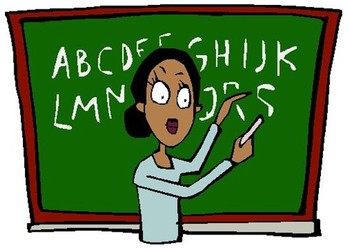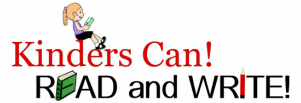
Go over ALL of the letters and sounds DAILY!
If you want to get your kids reading and writing this year, your first goal needs to be to make sure they know their letters and sounds. This should be a short-term goal, though — not an all-year one.
If you are teaching kindergarten, expect your kids to know all of their letters and sounds within two to four months. Some should pick them up even faster. Kids with serious developmental and/or speech delays may take a little longer. But ALL of your kids should know them within five months, TOPS. (If you are following the Kinders Can! READ and WRITE! program, they should not only know all of their letters and sounds by then, but how to read and write real words using them as well.)
One activity that can help your kids learn their letters and sounds very quickly is a daily alphabet review. An effective alphabet review covers each letter’s name, usual sound, and key word. I’m a fan of using hand signals that represent the letter as well. This helps your kinesthetic learners grasp them faster. It helps your more visual ones as well. Plus, it just makes it more FUN!
If you are a teacher wanting to add an effective alphabet review to your daily routine, simply gather your kids around your posted alphabet strip, and go over the letters, sounds, and key words associated with it. While doing so, teach your kids hand signals that look as much like the capital or lowercase letters on your strip as possible. Once they have the general idea of what to do, go through the whole alphabet, pointing at the letters, one at a time, as your kids say each letter’s name, sound, and key word. Be sure they are making the appropriate hand signals as well. Don’t worry if the review sounds a little tentative or choppy at first. Just work on making sure everyone says the same thing at the same time. Work on building speed and fluency as you go, pumping your kids up with compliments as they perform the drill. Remember to say such things as, “Good job, Johnny!”, ” Way to go Jose!” or, “Wow! I can hear Shamika way over here!”. This will really help to build enthusiasm as each child works to be recognized and/or please you.
If you are teaching kindergarten, expect your kids to know all of their letters and sounds within two to four months. Some should pick them up even faster. Kids with serious developmental and/or speech delays may take a little longer. But ALL of your kids should know them within five months, TOPS. (If you are following the Kinders Can! READ and WRITE! program, they should not only know all of their letters and sounds by then, but how to read and write real words using them as well.)
One activity that can help your kids learn their letters and sounds very quickly is a daily alphabet review. An effective alphabet review covers each letter’s name, usual sound, and key word. I’m a fan of using hand signals that represent the letter as well. This helps your kinesthetic learners grasp them faster. It helps your more visual ones as well. Plus, it just makes it more FUN!
If you are a teacher wanting to add an effective alphabet review to your daily routine, simply gather your kids around your posted alphabet strip, and go over the letters, sounds, and key words associated with it. While doing so, teach your kids hand signals that look as much like the capital or lowercase letters on your strip as possible. Once they have the general idea of what to do, go through the whole alphabet, pointing at the letters, one at a time, as your kids say each letter’s name, sound, and key word. Be sure they are making the appropriate hand signals as well. Don’t worry if the review sounds a little tentative or choppy at first. Just work on making sure everyone says the same thing at the same time. Work on building speed and fluency as you go, pumping your kids up with compliments as they perform the drill. Remember to say such things as, “Good job, Johnny!”, ” Way to go Jose!” or, “Wow! I can hear Shamika way over here!”. This will really help to build enthusiasm as each child works to be recognized and/or please you.
If you have any kids who already know their letters and sounds, let them be the “teacher” as soon as you think they understand what to do. By handing over your pointer and letting them lead the drill, you will free yourself up to pay
more attention to who is actually participating, etc. You will also make it into more of a “game”. Just make sure that the student you pick knows all of the letters and sounds. Otherwise, they will have a hard time keeping their place when pointing to the letters during this fast-paced drill. Don’t be afraid to tell your kids flat out that you can only pick those who already know their letters and sounds. This will encourage the others to learn theirs as well!
Once your students can go all the way through the alphabet with relative ease, do the same drill backwards! In other words, go from A-Z, then in reverse, from Z-A. This will add an extra challenge and make your kids have to pay attention to the letters again.
Regardless of whether you are going through the alphabet forwards or backwards, make sure you BUILD THE ENERGY as you review each letter, sound, and key word. This should be a FUN activity, NOT a chore.
There’s another component to this drill that you can add as well. When you are finished going through the whole alphabet with your kids, especially when you are first starting out, you can tell them that you are going to try to “trick them”! Tell them you are going to point to five letters in all, that you have five chances to “trick them”. Then make a big deal out of picking the letters you are going to point to, waving your pointer around to build anticipation as you decide. When you finally pick your first letter, playfully shout out, “What letter is this?” (Wait for their response.)
Then ask, “What sound does it make?” (Wait for response.) Then ask, “What’s the key word?” (Wait for a response.) After each correct response, make a really big deal out of “not being able to trick them”. Stomp your feet playfully, put your hands on your hips, look at them in disbelief, etc. Make a real game out of it. They will giggle with delight as you do so. Now, obviously, the kids who already know their letters and sounds will carry the ones who don’t as you “try to trick them”. But they’ll all be excitedly participating and learning, and that is what you want! Before you know it, they’ll all be able to “trick” you!
If you combine this alphabet review with other solid reading and writing activities (an effective letter of the week component, loads of interactive literacy charts, daily journal writing, etc.), your kids should be off and reading in no
time!
For more information on how to get your kindergartners reading and writing real books and passages, read my
Kinders Can! READ and WRITE! book. It’s full of activities like this and will help you get your kids really reading and writing this year.
All the best and much success,
Katy Huller
more attention to who is actually participating, etc. You will also make it into more of a “game”. Just make sure that the student you pick knows all of the letters and sounds. Otherwise, they will have a hard time keeping their place when pointing to the letters during this fast-paced drill. Don’t be afraid to tell your kids flat out that you can only pick those who already know their letters and sounds. This will encourage the others to learn theirs as well!
Once your students can go all the way through the alphabet with relative ease, do the same drill backwards! In other words, go from A-Z, then in reverse, from Z-A. This will add an extra challenge and make your kids have to pay attention to the letters again.
Regardless of whether you are going through the alphabet forwards or backwards, make sure you BUILD THE ENERGY as you review each letter, sound, and key word. This should be a FUN activity, NOT a chore.
There’s another component to this drill that you can add as well. When you are finished going through the whole alphabet with your kids, especially when you are first starting out, you can tell them that you are going to try to “trick them”! Tell them you are going to point to five letters in all, that you have five chances to “trick them”. Then make a big deal out of picking the letters you are going to point to, waving your pointer around to build anticipation as you decide. When you finally pick your first letter, playfully shout out, “What letter is this?” (Wait for their response.)
Then ask, “What sound does it make?” (Wait for response.) Then ask, “What’s the key word?” (Wait for a response.) After each correct response, make a really big deal out of “not being able to trick them”. Stomp your feet playfully, put your hands on your hips, look at them in disbelief, etc. Make a real game out of it. They will giggle with delight as you do so. Now, obviously, the kids who already know their letters and sounds will carry the ones who don’t as you “try to trick them”. But they’ll all be excitedly participating and learning, and that is what you want! Before you know it, they’ll all be able to “trick” you!
If you combine this alphabet review with other solid reading and writing activities (an effective letter of the week component, loads of interactive literacy charts, daily journal writing, etc.), your kids should be off and reading in no
time!
For more information on how to get your kindergartners reading and writing real books and passages, read my
Kinders Can! READ and WRITE! book. It’s full of activities like this and will help you get your kids really reading and writing this year.
All the best and much success,
Katy Huller

 RSS Feed
RSS Feed
